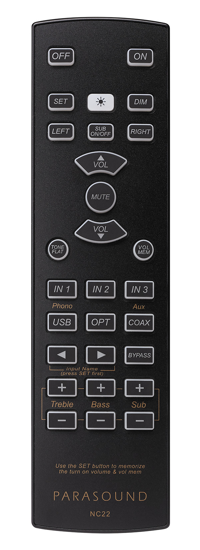
What comes to mind when you think of Class D amplification? Harsh? Clinical? Sterile? Digital? What if I told you Parasound has a Class D integrated amplifier that challenges and destroys all of these common misconceptions? When done well, a Class D amplifier can bring exceptional clarity, nuance, and accuracy to your listening experience. I’ve spent the past several months evaluating the Parasound NewClassic 200 Integrated ($1,195), and I think it will completely change your expectations of Class D amplification.
Even if you’ve had good experiences with Class D amplifiers in the past, the truth is that they’re not all created equal. The crucial element of their performance potential lies in the implementation of commercially available off-the-shelf Class D modules. Integrating these amplifier modules is where design engineers flex their engineering muscles to showcase Class D in its best light.
NewClassic 200 Description and Design Goals
After evaluating and auditioning several Class D modules, Parasound selected a 110wpc unit from Pascal Audio. Next, with thoughtful flexibility and using trickle-down technology from their flagship HALO line of products, Parasound designed a fully-featured integrated amplifier around this unit.
The NewClassic 200 integrated is a 12lb and 2.5″ tall chassis that contains a Burr-Brown DAC, an MM/MC phono stage, and a discrete headphone amplifier. On the back of the chassis, you’ll find dual subwoofer pre-outs with analog bass management and home-theater bypass inputs. The volume control uses a resistor ladder integrated circuit to attenuate the volume in the analog domain.

Parasound says the goal was to produce a neutral device with as much “plays well with others” as possible at a given price point. When you consider the value of a built-in DAC, phono preamp, and headphone amp, the NewClassic 200 integrated amplifier looks like it could be that perfect all-in-one product without costing you several thousand dollars. It also has the potential to surprise traditional Class A/AB amplifier purists who have yet to hear Class D done right.
NewClassic 200 Sound Quality
Right out of the box, I was impressed by what I heard. The clarity, detail, and grace were immediately apparent. The low noise floor and high signal-to-noise ratio created an expansive soundstage with good 3D stereo imaging effects. The tonal accuracy was admirable, with plenty of body and muscle.
The treble energy wasn’t overextended or artificially accented. Instead, it was simply present and exactly where it should be, providing an essential role without drawing attention to itself. The midrange was neutral and uncolored, choosing to let the speaker’s natural voice come through versus adding artificial warmth. The tight and controlled bass was remarkably fast and agile, never sounding sloppy or loose.
This agility and speed in low-frequency reproduction created a rhythmic bedrock for the music and set the pace of the performance, especially during complex passages in electronic and rock music. The NewClassic 200 was also fully capable of subtlety and grace when reproducing the more organic and nuanced bass found in blues and jazz.
Usability of the NewClassic 200

When on, this amplifier is barely warm to the touch. Despite its slim size, it is completely rigid, with no chassis flex or movement. The front panel input and volume control knobs have a tactile soft-touch finish, and the remote feels solid with an intuitive button layout.
I especially like the retro-style backlit LCD screen that inverts the color of its text from green to black depending on the viewing angle. This simple but welcome design makes the screen easy to read from anywhere in the room.
Parasound also thoughtfully included the ability to adjust the tone controls via the remote control. This remote is well-designed and easy to use. You can easily revert to the default settings by pressing the tone flat button on the remote.
These controls are also well-implemented and capable of minute adjustments. This enhanced my overall listening experience and allowed for greater flexibility with speaker pairings, room acoustics, and different levels of recording quality. For example, if I wanted to increase the volume to 80-85db and the treble got a little hot on a particular recording, it was easy to adjust the treble to -3 or -4 without affecting the overall musicality or tonal structure.
Speaker Pairings
Elac Adante AS-61: I spent most of my time with the NewClassic 200 powering the Elac speakers. The perfect synergy with these difficult-to-drive 4ohm speakers was unmistakable. There was ample power on tap, making them sound like they each had 8″ subwoofers. In addition to the pleasurable and clean bass response, they had a strong midrange presence and body. I especially enjoyed their rich tonality and quick rhythmic drive. No matter what genre of music I tried, they sounded better and better as I turned up the volume and really gave them some juice. This pairing was highly addicting and endlessly listenable.
PMC twenty.22: As I hooked up my reference monitors, I asked myself several questions. Is the noise floor of this amplifier low enough? Will the treble energy be adequately refined through these highly resolving speakers? Is there enough current to get the transmission line woofers moving? The answer to all of these questions was a resounding yes. Additionally, the abundant 3D stereo imaging effects were palpable. This made for several “wow” moments as I experienced the sensation of sound wrapping around my head and whipping past my ears. This pairing demonstrated what I consider to be a true Hi-Fi experience on a budget.
Epos K1i: The differences I heard when going from a $4,000 pair of PMCs to the Epos K1i (which can be found used for around $400) weren’t as dramatic as I had expected. The NewClassic 200 allowed these inexpensive speakers to throw a wide soundstage with a satisfying and smooth midrange that reminded me of butter-soft leather. The overall sound was effortless and detailed, and the bass had a good impact and body. I highly recommend this pairing if you are looking to get the most for your dollar.
Triangle Comete EZ: The Triangle speakers have arguably the most revealing tweeter of the group — a horn-loaded titanium dome. If there were any shortcomings in the Parasound’s treble delivery, I would certainly have noticed it with these unforgiving speakers. Instead of shortcomings, what I heard was an enveloping wave of sound that washed over me, demanding my attention. This striking sound quality drew me into the performance and kept me engaged in the music. Balancing out the pristine highs was an organic-sounding midrange and deep bass that didn’t sound like it was coming from a bass-reflex enclosure.
DAC, Phono Stage, and Headphone Amplifier
I directly compared the NewClassic 200 integrated amplifier’s internal Burr-Brown PCM1798 DAC against the dual Wolfson DACs in my Cambridge Audio CXN V2 streamer ($1,100). I couldn’t hear any meaningful differences, so I stopped comparing and just enjoyed listening with the internal Burr-Brown DAC from that point. I could tell by its detailed and musical presentation, Parasound paid special attention to this DAC’s implementation.
I connected my vintage Technics SL-1200MK2 turntable equipped with a modest Ortofon OM30 cartridge to the built-in phono preamp and queued up both old and new vinyl records. Regardless of the age of the record or the genre of music, I experienced deep black backgrounds and a refined purity in the tonality of instruments and voices. I loved the complex and layered soundstage and that unmistakable ease and bold character you can only truly get with vinyl.
This pairing convinced me that it’s not necessary to spend thousands of dollars on an analog frontend to achieve enjoyable vinyl playback. It’s clear that the phono stage is not simply an afterthought or cheap add-on. Care has gone into its design, affirming Parasound’s passion and commitment to vinyl as a cherished medium for many music lovers.
The headphone amplifier played loud and strong with the headphones I tried, but it did so with a somewhat dry presentation. It wasn’t clinical, but I have a feeling that it would pair up well with darker and more laid-back headphones.
Caveats
In general, I have no complaints about the overall build quality, but I would have appreciated higher-quality speaker binding posts such as those found on Parasound’s HINT 6 integrated amplifier. Those are larger and grip the banana plugs more effectively. The posts on the NewClassic 200 felt slightly loose and didn’t seem to have a firm grip on my speaker cable’s banana plugs.
Lastly, I felt that the headphone amplifier could use just a touch more tonal richness in order to provide a weightier more satisfying sound.
Conclusion and Value
When you compare the Parasound NewClassic 200’s retail price against its feature set and standout audio quality, the value is obvious and remarkable. If you love accuracy, detail retrieval, and neutrality then it’s an excellent choice.
Will it give you the lush midrange and emotional impact of a tube amplifier that costs three times the price? No, nor would I expect it to. Instead, it delivers an expansive and immersive soundstage, palpable 3D stereo imaging effects, and an extraordinarily detailed and nuanced presentation.
Will this level of performance completely disrupt your assumptions about how Class D sounds? Without a doubt.
Price: $1,195
Technical Specifications: Click here to view them on Parasound’s website.


VG review. Not all class “D” amps are flawed as you have found out. Try an Arion HS 500 hybrid.
I would be interested to know more about how Parasound managed all the different power requirements in such a small package. There is a lot going on here, with a lot of different types of technologies requiring different power and introducing different noise factors into the power signal.
Hi , I found another test of this small Parasound amplifier which shows several detailed photos, one of which shows the inside of the device!
https://www.hifitest.de/test/bildergalerie/vollverstaerker/parasound-newclassic_200_integrated_18980/9#b
It just looks so digital and cold from the outside, i will have to test it for myself, interesting amp
I very much enjoyed the review of this integrated and I happen to have the Epos K1i. I also can buy any of the other 2 speakers you tested it with, the Adante AS-61 and PMC twenty.22. I’m fortunate I have some money later in life.
I’m hoping you can help me with a question, since I can afford all 3 speakers and have the Epos k1i, I’m wondering if pairing with either of the other two would bring greater audio quality. While I have a combined listening space living room\kitchen dining room of say 20ft x 25ft my setup is in the living room with current speakers 7-9 apart and listening position about 8-10ft.
While I enjoy all types of music, a good balance of detail, bass and warmth is always welcoming to me.
I would appreciate any thoughts.